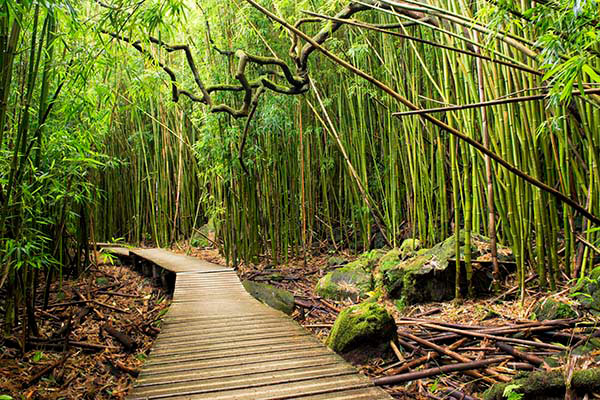
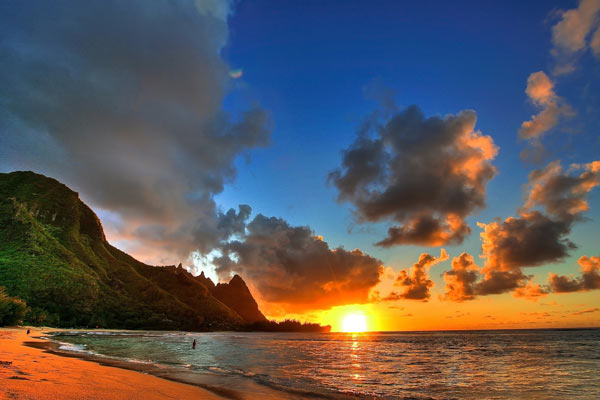
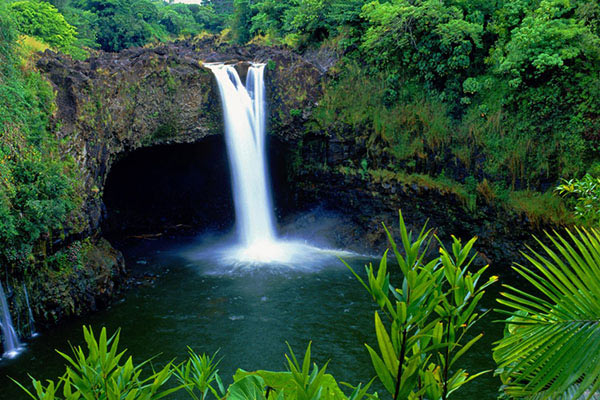

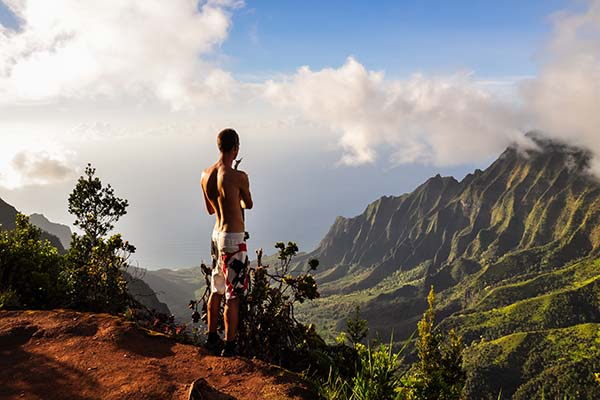
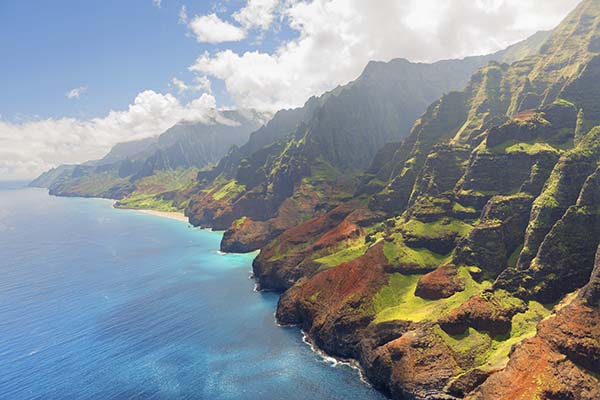
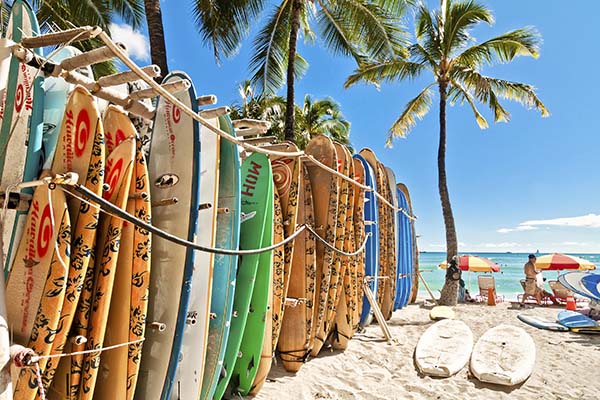
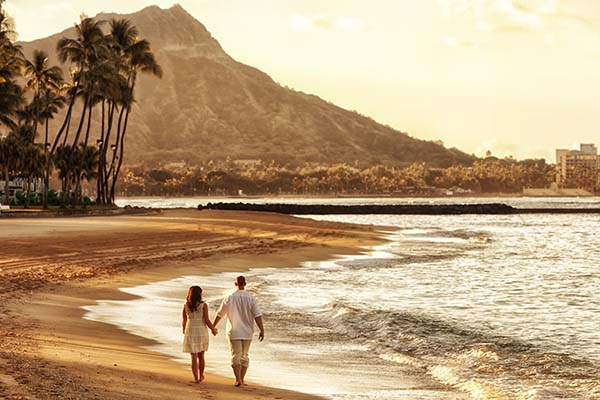
Hawaii
The U.S. State of Hawaii is made up of eight volcanic islands in the Central Pacific. Six are open to travel: Oahu, Maui, Kauai, Molokai, Lanai, and Hawaii (the Big Island). They’re known for their ideal surfing beaches, tropical flowers and foliage, and picturesque waterfalls and cliffs. The local people offer a warm rich history and generous aloha lifestyle for you to savor. It’s also the home of Pearl Harbor’s WWII Memorials. In this lush paradise you have the chance go snorkeling with the colorful fish in the coral reef at Molokai, play golf with the pros at the famed Turtle Bay Resort, and go hiking at daybreak up at Diamond Head for panoramic views of Oahu. Whether you want gripping outdoor adventure or a peaceful relaxation escape, the Hawaiian Islands won’t disappoint.
Did You Know?
- Hawaii was the 50th state admitted to the union on August 20th, 1959.
- Hawaii is the only state in the USA that grows coffee, cocoa, and vanilla beans.
- The Hawaiian Islands are the projecting tops of the biggest mountain range in the world.
- Hawaii is the only state in the USA that is growing. The Big Island (Hawaii Island) is getting bigger by about 42 acres each year due to the continuous eruption of the Kīlauea Volcano, the most active volcano on Earth. It’s been erupting for more than 30 years!
- The Hawaiian language has only 12 letters, and every word ends with one of the 5 vowels.
- Hawaii has the highest life expectancy of any state in the United States.
- The hula dance was originally a dance meant for worship, performed by skilled men who were purportedly taught by the Hawaiian god Luka.
- Hawaii has its own time zone, and doesn’t follow Daylight Saving Time.
- Hawaii has a green sand beach Papakalea, which gets its color from olivine crystals formed by volcanic eruptions. Hawaii also has red, black, white, and golden-yellow sand beaches.
- The Hawaiian Lei is a wreath of any of nature’s gifts (flowers, leaves seeds, nuts etc.), and shouldn’t be thrown away, and instead be returned to the earth by hanging as a decoration, burying, or burning.
- Hawaii was originally called the Sandwich Isles, named by Captain James C. Cook in 1778 in honor of his patron the Earl of Sandwich.
Travel Tips
US citizens do not need a passport to travel to Hawaii, as long as you have proper government-issued ID and your birth certificate. However, new restrictions at some state airports are requiring you to have a passport to travel, so it’s best to have a valid passport if possible. If you’re passing through Canada on your route to Hawaii, you’ll also need to present your passport. And, if you’re a citizen from another country, you will need a passport. You’ll also need a visa, unless your country is included in the Visa Waiver Program and travelling less than 90 days. Canadian citizens may also present a NEXUS card instead of a passport, if they are enrolled in the traveler program.
The climate in Hawaii makes it a great place to visit any time of year. The average temperature runs between 75F-85F all year. Summer runs from April to November, when it’s warmer and drier. The highest recorded temperature is just 96F, and temperatures over 92 generally occur rarely – just one or two times a year. December through March are a bit cooler, and average daytime temperatures are 72F in January. There are some trade winds, and lots of rainfall to keep the islands lush. Interestingly though, most of the rainfall occurs overnight. You may feel a light sprinkle while you’re laying in the sun, but it usually won’t last long. And if you’re into whale watching the season begins in late December and ends in early May, peaking in February.
Hawaii’s currency is the US dollar, so Traveler’s Cheques are rarely necessary. Credit and debit cards are accepted widely throughout the islands, and ATM machines are also easily found. As always, it’s wise to carry a combination of cash and cards, especially in the more remote areas.
There are parts of Hawaii where your mobile phone may not work because the coverage is not very consistent. Check with your wireless carrier before you leave to see what your options are. If you need to stay in touch regularly, you may need to rent a phone from InTouch USA http://intouchglobal.com/, or get a temporary plan from Hawaiian Telcom. http://www.hawaiiantel.com/ For internet access, there’s Wi-Fi available at many hotels and coffee shops in the more populated areas. Another reliable option if you need internet access is to get a non-resident library card. The Hawaii State Public Library has free computer use with Internet access. www.librarieshawaii.org/services/libcard.htm.
The public bus system is a great way to get around in most islands, and there are plenty of taxis available in the bigger areas too. Uber is also now available on several of the islands, but note they are not allowed to pick you up at the airport. They also have plenty of car rentals, which is great for exploring the islands. If you decide to drive yourself, note that they are more polite and considerate in allowing for merging – and will expect the same from you. And don’t honk the horn, unless it is an emergency! Going between islands is best on a plane, and they also offer helicopter tours to see incredible views and/or hard-to-get-to remote areas.